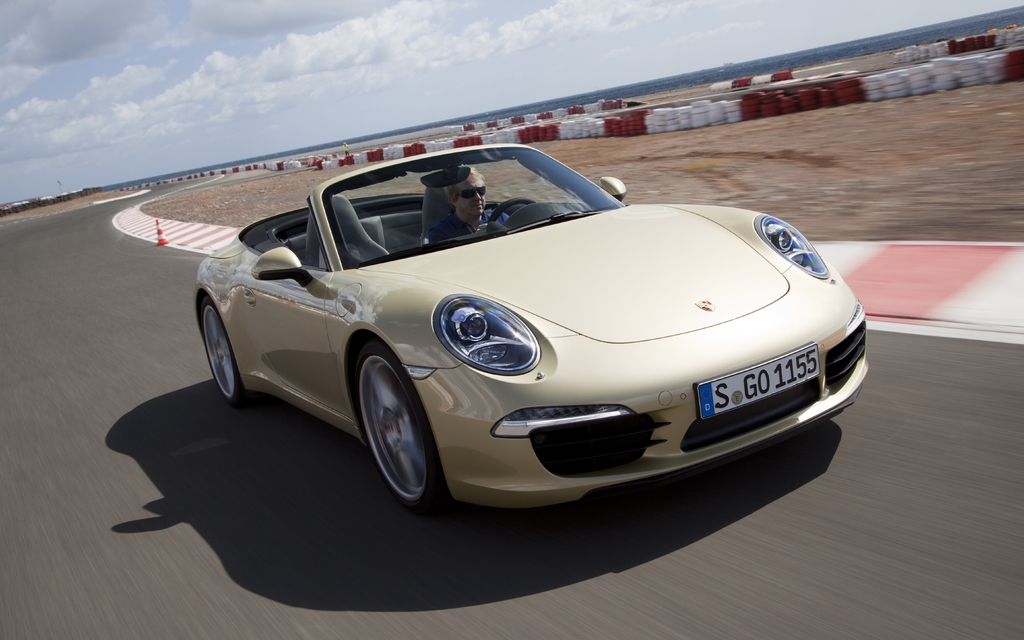2012 Porsche 911 Cabrio: Topless and loving it
This April marks the arrival of the Cabrio and the beginning of a new cycle for the Porsche 911, mere months after the launch of the all-new 2012 Carrera and Carrera S. A series of variants and trim levels are set to follow with all-wheel drive and turbocharged engines, allowing Porsche to release a “new” 911 every six months for the next five years.
In any new cabriolet review, you have to mention what separates the convertible from the coupe, namely the soft top. This time, the 911 Cabrio’s designers have preserved the Coupe’s roofline while the engineers added three magnesium panels between the cloth layers to reduce wind noise and help the roof keep its shape when travelling at speed. As was the case with the previous model, the soft top takes just 13 seconds to go up or down, even when the car is moving – provided that it’s not travelling faster than 50 km/hr. But the new 911 Cabrio’s wind deflector deploys in a mere two seconds at the touch of a button. This is much more practical – and civilized – than the previous generation’s deflector, which had to be put in place manually.
350 or 400 horses
The Cabio features the same drivetrains as the Coupe. There’s a 3.4L boxer engine that produces 350 horses, while the Carrera S’s 3.8L produces 400 horses. Like the Coupe, the Cabrio comes standard with the new seven-speed manual gearbox, although buyers can opt for a seven-speed double-clutch PDK. As you’d expect, the 911 boxer engine’s evocative sound is a lot more noticeable when you drive the Cabrio with the top down. But with the top up, the soundproofing on the new convertible is comparable to the Coupe’s.
Roaring up the mountainous roads of Gran Canaria, I was really impressed with the Cabrio’s handling and dynamic ride – owing to its remarkable grip. What’s more, its power steering provides excellent feedback and you can really feel the front tires working. The convertible weighs about 70 kilos more than the Coupe, its chassis doesn’t have the same torsional rigidity, and it takes three-tenths of a second longer to hit 100 km/hr – but I would never have known if I hadn’t read the technical specs for both versions. As for dynamics and performance, the Cabrio is almost as good as the Coupe, which means you don’t have to give up much for the pleasure of driving with the wind in your hair.
Seven-speed manual
The new seven-speed manual gearbox is absolutely brilliant thanks to the shifter’s tremendous precision and the short distances between gears. Of course, the double-clutch PDK transmission shifts faster and improves fuel consumption. But for those of us who spent our youth mastering the art of downshifting using the heel-toe technique, it’s comforting to see that a manufacturer like Porsche still devotes time and money to developing manual gearboxes. Their efforts are to be applauded, given that this technology is steadily becoming a lost art in this era of the modern automobile.
The new 911 Cabrio does not disappoint. It’s surprisingly comfortable for a high-end sports car and remains laid back in seventh gear at low revs. When you feel the need for a more inspired ride, simply select Sport mode and allow yourself to be dazzled by the car’s balance and remarkable confidence when attacking turns.
Prices and praise
The 911 Cabrio will arrive in Canadian Porsche dealerships in April. The Carrera Cabrio will sell for $106,900 while the Carrera Cabrio S will go for $123,200. Tacking on the optional PDK gearbox or ceramic composite brakes will raise the price by $4,660 and $9,730, respectively. With this new Cabrio, Porsche has crafted a convertible whose ride is almost on par with that of the Coupe. Hats off to you, Porsche!












